Pesticide Usage in Scotland: Arable crops and Potato stores 2022
This publication presents information from a survey of pesticide use on Arable crops and Potato stores in Scotland during 2022.
General trends
Crop area
The estimated area of arable crops grown in 2022 was 487,389 hectares (Table 28). This represents a two per cent decrease from 2020(3) and no change from 2018(4) (see Appendix 4 for changes in methodology between years). Since the last survey, areas of winter barley, wheat, winter oats, winter rye, oilseeds and legumes increased (3, 15, 6, 40, 15 and 23 per cent respectively), while spring barley, spring oats, seed potatoes and ware potatoes have decreased (9, 28, 1 and 6 per cent respectively) (Table 28, Figures 1 and 2).
In 2022, cereals accounted for 87 per cent of the arable area (48 per cent spring barley, 22 per cent wheat, nine per cent winter barley, four per cent spring oats, two per cent winter oats and one per cent rye). The remaining area consisted of oilseeds, potatoes and legumes (accounting for 7, 6 and 1 per cent respectively, Figure 3). The largest area of arable crops was in the Aberdeen region, followed by Angus, Tweed Valley and Moray Firth (Figure 4).
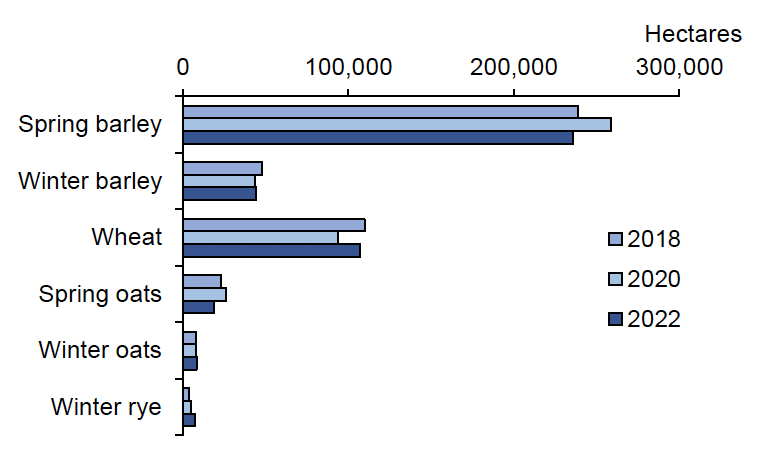
Note: triticale has been excluded as this represents < 500 ha.
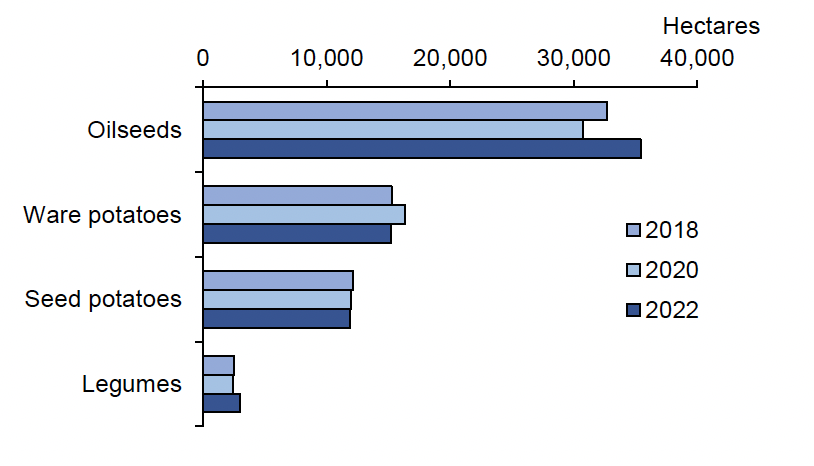
Note: oilseeds includes linseed (2022 only), winter and spring oilseed rape; legumes include field beans and dry harvest peas.
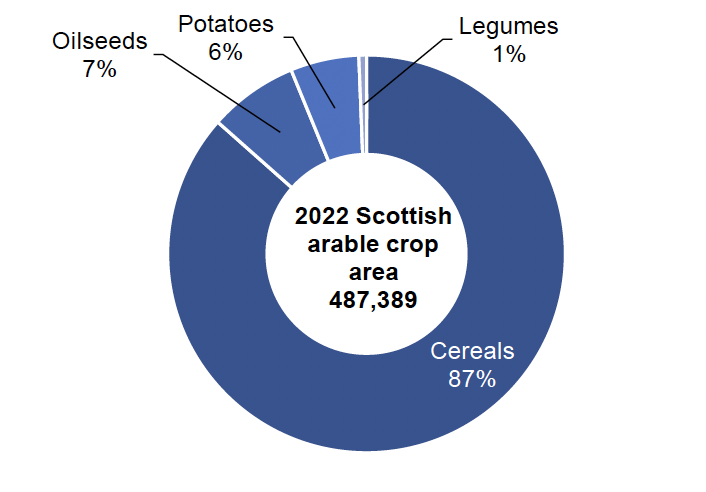
Note: cereals include winter and spring barley, wheat, oats, winter rye and triticale; potatoes includes seed and ware potatoes; oilseeds includes linseed, winter and spring oilseed rape; legumes includes field beans and dry harvest peas.
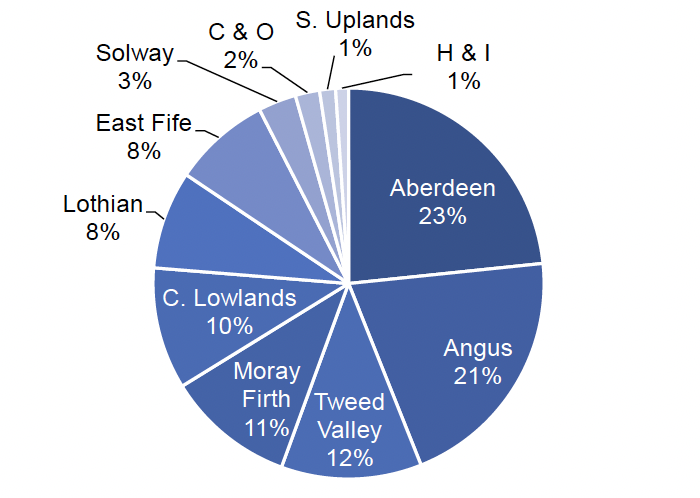
Note: H & I = Highlands and Islands, S. Uplands = Southern Uplands, C & O = Caithness and Orkney and C. Lowlands = Central Lowlands.
Pesticide usage
In 2022, as in 2020, the majority of arable crops (97 per cent) received a pesticide treatment.
Winter and spring barley, winter and spring wheat, winter oats, winter rye, oilseeds, seed and ware potatoes had the highest overall proportion of crop treated with a pesticide (between 96 and 100 per cent Table 1). Legumes and spring oats had lower proportions of treated crop area (91 and 83 per cent respectively). The average number of sprays applied to treated arable land, excluding seed treatments was 4.1, the same as recorded in 2020. Ware potatoes and seed potatoes received the highest average number of sprays (13.7 and 10.2 respectively), while spring barley, spring oats and winter rye received the lowest (2.5, 2.7 and 3.2 respectively, Table 1). These figures only apply to the treated area of crops.
It is estimated that the area of arable crops treated with a pesticide formulation in 2022 was ca. 4,685,000 hectares compared with ca. 4,793,000 hectares in 2020 and ca. 4,632,000 hectares in 2018 (Table 21, Figure 5). This represents a decrease of two per cent since 2020 and is very similar to 2018.
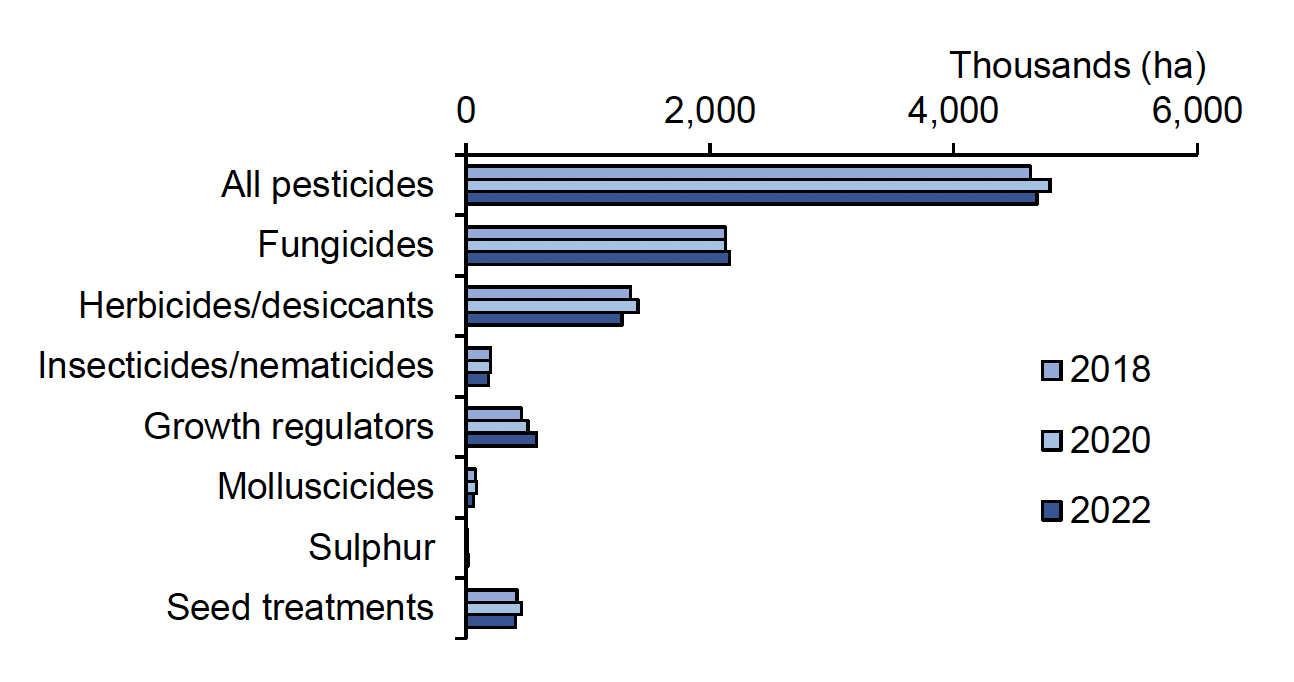
In terms of weight of pesticide applied, it is estimated ca. 1,200 tonnes were applied in 2022, representing a decrease of 12 per cent from 2020 and a decrease of eight per cent from 2018 (Table 21, Figure 6).
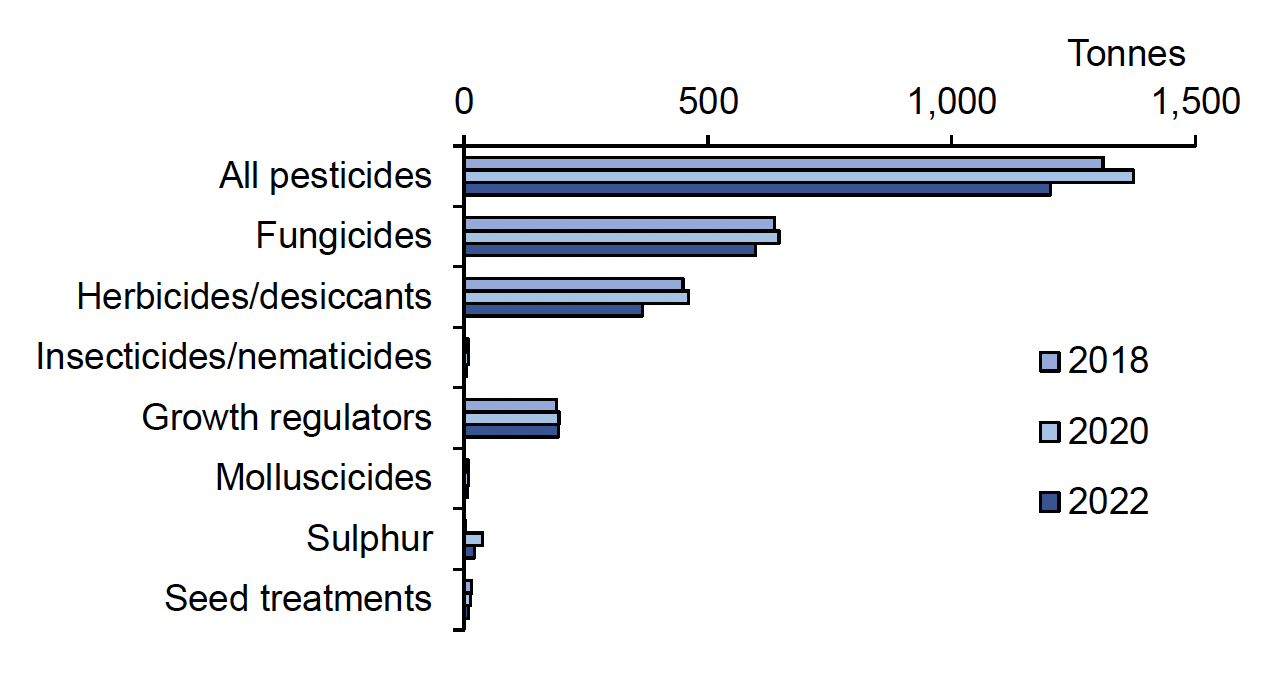
In order to make accurate comparisons between the 2022 data and the data collected in previous surveys, it is important to take into account the differences in crop area between survey years. Therefore, the number of treated hectares per hectare of crop grown and the total weight of pesticide used per hectare of crop grown were calculated. Once crop area is taken into account, there was no change from 2020 to 2022 and a two per cent increase from 2018 to 2022 in terms of the total pesticide treated area per area of crop grown (Figure 7).
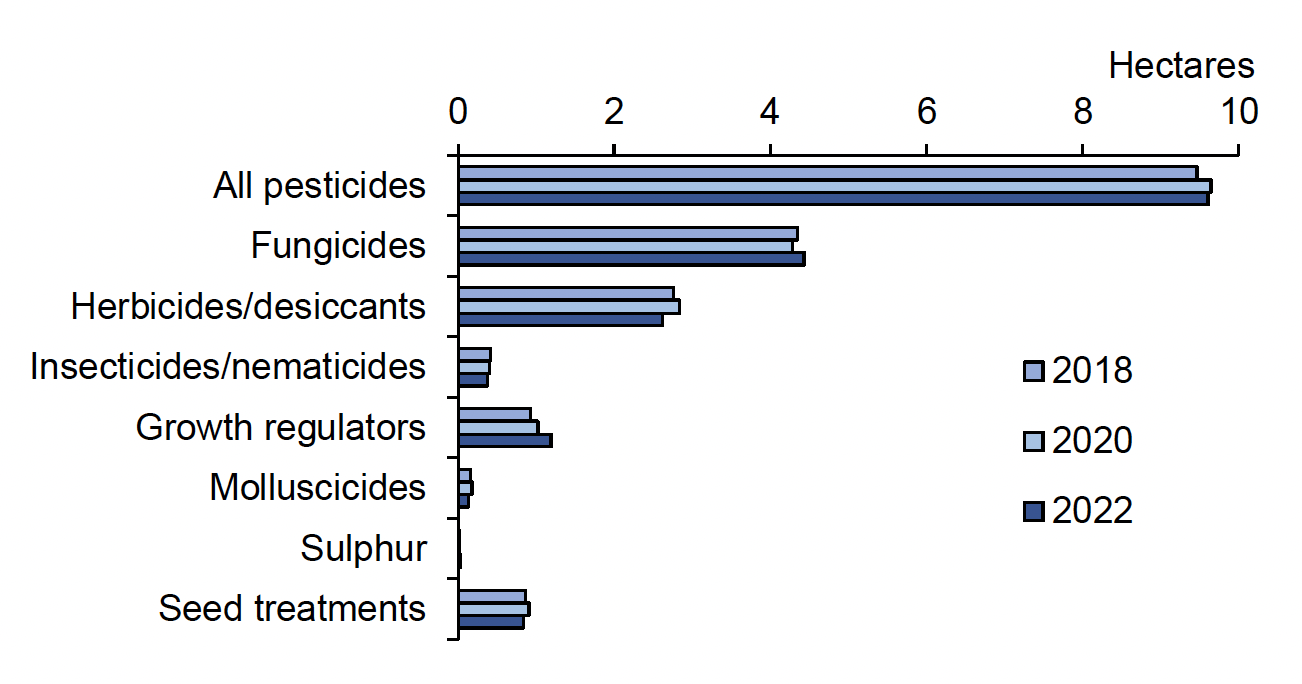
In terms of quantity of pesticides used per hectare of crop grown, there was a decrease of 11 per cent from 2020 to 2022 and a decrease of eight per cent from 2018 to 2022 (Figure 8).
Overall, winter crops for harvest in 2022 established well and a dry spring reduced disease pressure. Spring crops went in to cool, dry soils and there were some issues with emergence but establishment was usually good. Soils were very dry going into summer but rainfall in June and July went some way to alleviating this and crop yields were generally good despite being capped by earlier low rainfall. Pest and disease levels were reduced by the dry spring, but increased in wetter summer conditions(5).
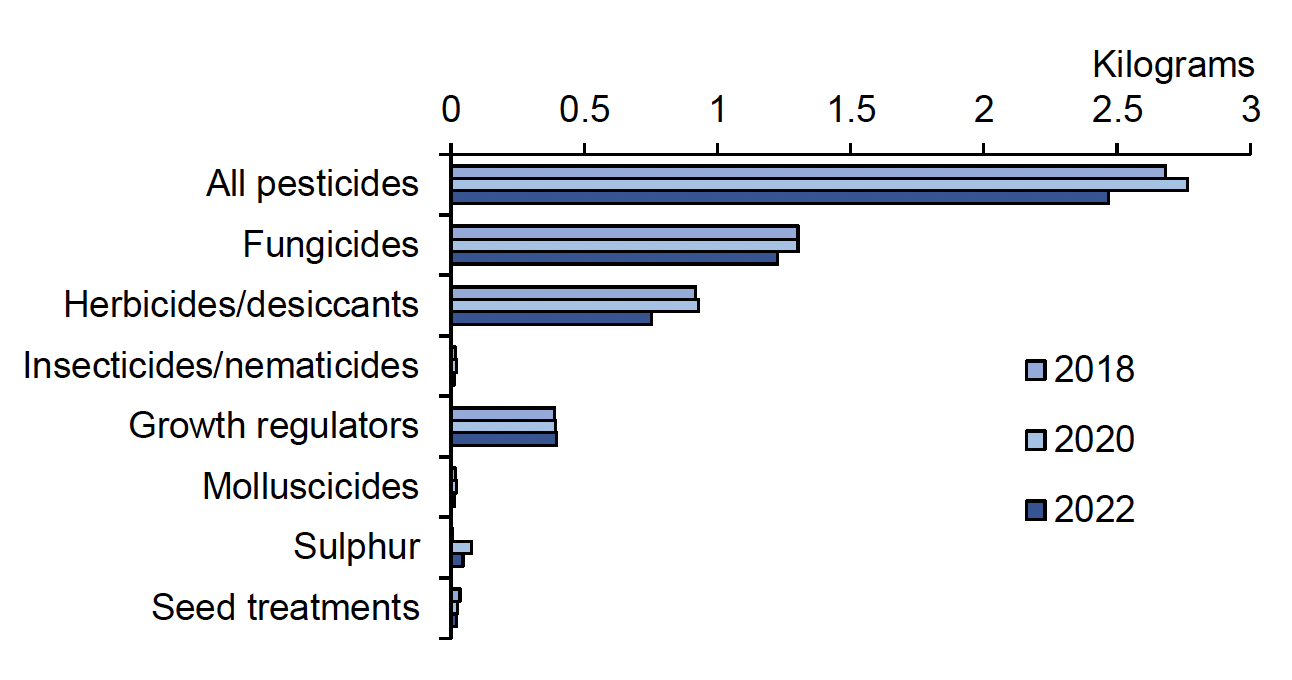
As in previous surveys in this series, fungicides were the most frequently used pesticides on arable crops, followed by herbicides/desiccants (Figure 5). In 2022, fungicides accounted for 46 per cent of the total pesticide treated area and 50 per cent of the total weight of active substances applied (Figures 9 and 10). When changes in crop area are taken into account, there was a three per cent increase in area treated with fungicides from 2020 to 2022, and a two per cent increase from 2018 to 2022 (Figure 7). The weight of fungicides applied per hectare decreased six per cent from both 2020 and 2018 to 2022 (Figure 8). The slight increase in treated area but decrease in weight applied may have been influenced by the withdrawal of chlorothalonil (May 2020), which would have been part of early programmes that year. To achieve the same degree of efficacy from programmes in 2022, other fungicidal inputs will have increased, including increased use of folpet, which is applied at lower rates than chlorothalonil, contributing to the decrease in weight of fungicide applied from 2020.
In 2022, herbicides/desiccants accounted for 27 per cent of the total pesticide treated area and 30 per cent of the total weight of active substances applied (Figures 9 and 10). When changes in crop area are taken into account, there was an eight per cent decrease in the area treated with herbicides/desiccants from 2020 to 2022 and a five per cent decrease from 2018 to 2022. The weight of herbicides/desiccants applied decreased 19 per cent from 2020 to 2022 and decreased 18 per cent from 2018 to 2022 (Figures 7 and 8). Prolonged dry conditions in spring delayed weed germination(6), and weed levels continued to be fairly low as a consequence of the dry weather continuing through the summer months(7,8). The area treated and weight applied of pre-harvest glyphosate decreased 34 and 35 per cent respectively in 2022 compared to 2020, likely due to the hot, dry weather at harvest time rapidly ripening crops naturally(7,8).
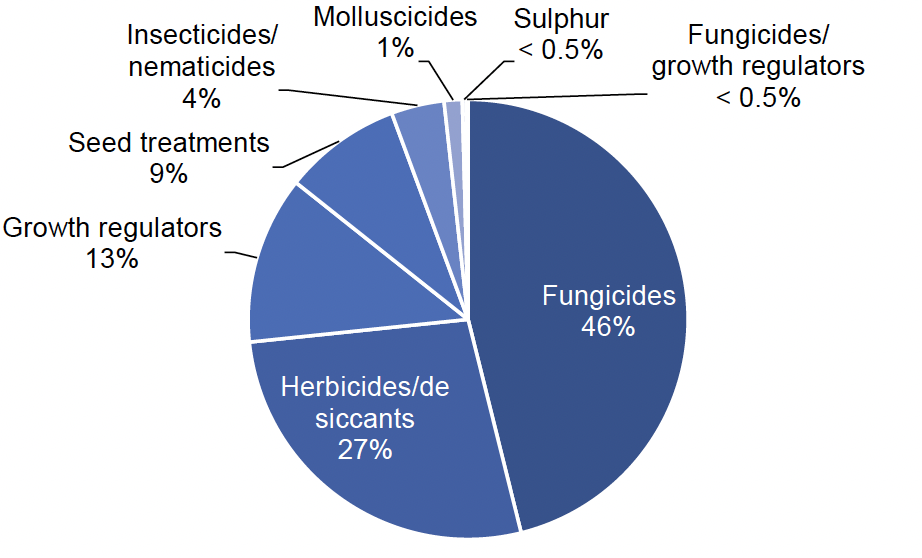
As was the case in 2020, insecticides (including nematicides) accounted for four per cent of the total pesticide treated area but less than 0.5 per cent of the total weight of active substances applied (Figures 9 and 10). When changes in crop area are taken into account, there was a seven per cent decrease in area treated with insecticide from 2020 to 2022 and a 10 per cent decrease from 2018 to 2022 (Figure 7). The weight of insecticides applied per hectare of crop grown decreased 50 per cent from 2020 to 2022 and decreased 42 per cent from 2018 to 2022 (Figure 8). This decrease in weight of insecticides applied since 2020 is primarily influenced by the withdrawal of oxamyl (final use December 2020) which was previously applied at high rates at planting of potato crops for the control of nematodes. The decline in insecticide use may also have been influenced by the withdrawal of thiacloprid in February 2021, which was previously applied mainly as a foliar spray to potato crops for aphid control.
Molluscicides accounted for one per cent of the total pesticide treated area and of the total weight of active substances applied (Figures 9 and 10). When changes in crop area are taken into account, there was a 28 per cent decrease in area treated from 2020 to 2022 and a 17 per cent decrease from 2018 to 2022 (Figure 7). The weight of molluscicides applied per hectare of crop grown decreased by 29 per cent from 2020 to 2022 and by 26 per cent from 2018 to 2022. The decrease in area treated and weight applied of molluscicides since 2020 is influenced by the withdrawal of the active substance metaldehyde in March 2022, which meant it was not available for use on potato crops during the 2022 season. Metaldehyde was applied to winter cereal and oilseed rape crops planted late 2021 and none after March 2022. Notably, there was also a 13 and 24 per cent decrease in the area treated and weight applied of ferric phosphate, the only approved molluscicide active substance, from 2022 to 2020. Favourable autumn 2021 and spring 2022 crop growing conditions likely reduced slug pressure, allowing emerging crops to advance quickly(9,10,11). This is in contrast to the 2020 season, where heavy autumnal rainfall in 2019 favoured slugs, and growers were reliant on slug pellets for slug management in oilseed rape and wheat during the autumn(12,13). Wet weather during summer 2020 also increased slug pressure on potato crops(14).
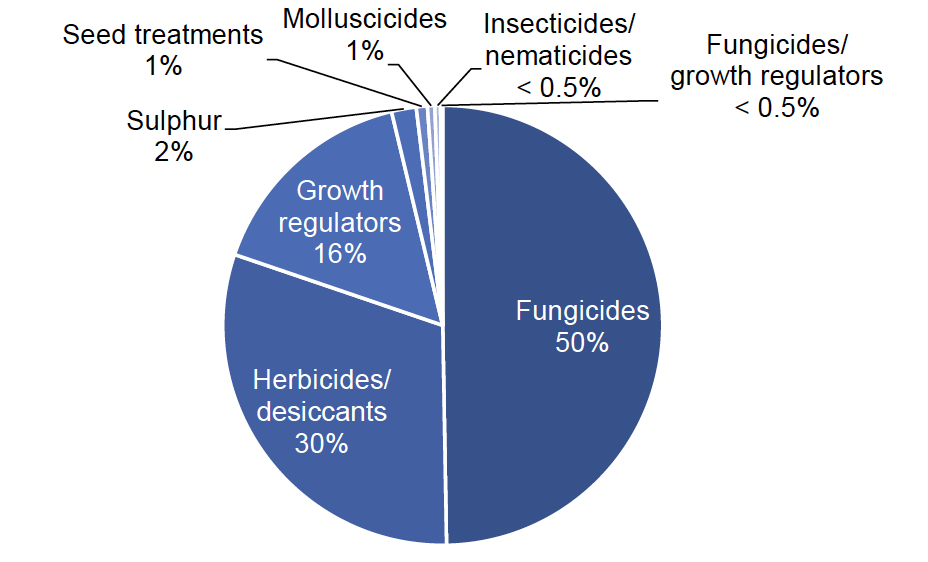
Growth regulators accounted for 13 per cent of the total pesticide treated area and 16 per cent of the total weight of active substances applied (Figures 9 and 10). When changes in crop area are taken into account, the area treated increased by 16 per cent from 2020 to 2022 and by 28 per cent from 2018 to 2022 (Figure 7). The weight of growth regulators applied per hectare of crop grown increased by one per cent from 2020 to 2022 and increased two per cent from 2018 to 2022 (Figure 8). As crops established well in 2022 and had good potential from early in the season, preventing lodging was a priority for farmers (Prof. Fiona Burnett, pers. comm).
Seed treatments accounted for nine per cent of the total pesticide treated area and one per cent of the total weight of active substances applied (Figures 9 and 10). When changes in crop area are taken into account, there was an eight per cent decrease in area treated between 2020 and 2022 and a three per cent decrease between 2018 and 2022 (Figure 7). The weight of seed treatments applied per hectare decreased 17 per cent from 2020 and by 38 per cent since 2018 (Figure 8). The decrease in the area and weight of seed treatments applied may relate to the withdrawal of some seed treatment formulations since the previous survey, including thiram which was the principal seed treatment on winter oilseed rape in 2020 (withdrawn January 2020) and penflufen and pencycuron which were common seed treatments on potatoes in 2020 (withdrawn June 2021 and March 2020 respectively).
Sulphur accounted for less than 0.5 per cent of the total pesticide treated area and two per cent of the total weight of active substances applied (Figures 9 and 10). When changes in crop area are taken into account, there was a 51 per cent increase in area treated from 2020 to 2022 and a 775 per cent increase from 2018 to 2022 (Figure 7). The quantity of sulphur applied per hectare of crop grown decreased by 44 per cent from 2020 to 2022 and increased 696 per cent from 2018 to 2022 (Figure 8). Sulphur, applied primarily to cereals, is a multisite alternative to fungicides and was used to control mildew, septoria and rhynchosporium. Spring barley and winter wheat accounted for 87 per cent of the sulphur treated area (43 and 44 per cent respectively) and 89 per cent of weight applied (45 and 44 per cent respectively) in 2022.
Three active substances were recorded for the first time in the 2022 arable survey (Table 18). These included the herbicide thiencarbazone-methyl (for brome control in winter wheat) and the fungicides fenpicoxamid (for disease control in cereals) and laminarin (a plant health elicitor which protects crops from fungal attack by activating the crops own defence systems and is one of the first biopesticides authorised for control of septoria and reduction of powdery mildew in winter wheat).
Whilst overall use of pesticides in 2022 has remained broadly similar to the previous two arable surveys, some individual active substances have exhibited considerable change. Declines or gaps in azole efficacy have influenced the use of a number of fungicides. The most effective remaining azole after withdrawal of the single-site fungicide epoxiconazole (withdrawn October 2021) was prothioconazole, the efficacy of which has declined against septoria and has always been slightly lower against rusts. This may have influenced increased use of the new active substance mefentrifluconazole (increased by 220 per cent in terms of area treated and 237 per cent by weight compared to 2020). The withdrawal of the multi-site chlorothalonil in May 2020 likely influenced increased use of the multi-site fungicide folpet (69 per cent increase of area treated and 80 per cent by weight compared to 2020 (Tables 19 and 20). The area treated and weight applied with the fungicide benzovindiflupyr also increased by 107 and 104 per cent respectively, partly influenced by crop composition, with greater areas of rye and field beans grown in 2022. In contrast, use of the potato fungicide cymoxanil decreased by 37 per cent by area treated and 33 per cent by weight applied. The principal cymoxanil formulation in 2020 was cymoxanil/mancozeb. Use of this formulation was significantly lower in 2022 possibly due to supply issues in GB following the withdrawal of mancozeb in the EU in January 2021. Use of the fungicide prochloraz decreased by 57 per cent in area treated and 55 per cent in weight applied, influenced by product availability. A product containing prochloraz/proquinazid/tebuconazole was applied to 7,500 ha of cereals in 2020 but its use was withdrawn on barley and oats in July 2020.
While the overall area treated and weight applied of seed treatments decreased, the increased use of imazalil and ipconazole (123 and 128 per cent of area treated and 125 and 137 per cent by weight applied) may have been due a decrease in the overall number of seed treatments available. In addition, the area treated and weight applied of glyphosate decreased 34 and 35 per cent respectively in 2022 compared to 2020, this is likely to have been influenced by the hot, dry weather pre-harvest, rapidly ripening crops and naturally reducing the need for a desiccant. Use of the herbicide mecoprop-p also decreased by 44 per cent for area treated and 42 per cent by weight applied possibly due to the dry conditions and lower weed pressure in 2022. Finally, the withdrawal of linuron (June 2018) and diquat (February 2020) have will have led to an increase in use of other active substances such as the herbicide aclonifen, predominantly on ware potatoes, with an overall increase of 134 per cent in both area treated and weight applied. Aclonifen was a new active introduced in 2019.
Contact
Email: psu@sasa.gov.scot
There is a problem
Thanks for your feedback